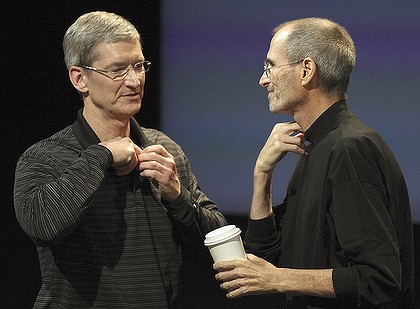Steve Jobs was an amazing salesperson. He was a master of the art of connecting with customers and clients not only on the small screen, but also on the bigger platforms during his new product roll outs. How Steve and Apple changed what we expected from a leadership brand.
Since Apple is in the news for other reasons this week I thought I’d revisit and update an older article I wrote about Steve Jobs and Apple. I have been involved with Apple products since the mid 1980’s where my business in Northern Ohio brought many of Apple’s computer products to a consumer electronics chain called Northeast Consumer Technologies.
We were one of the first electronic superstore chains located here in the Midwest. I’ve almost always had Apple products in our home because my wife just loved the way the products helped her do her job as instructional designer and editor for my many training manuals.
I enjoyed them as well because I wasn’t as technology friendly as I am today. Much of my new work in health care technologies today centers on how the Apple products can be used to change the way we treat patients. I’m getting ready to order an iPad Pro to see how our clients’ doctors and nurses might be able to use the technology to improve patients’ healthcare experiences.
Over the years I’ve experienced the Apple leadership brand first hand when I was Regional President for Microsoft Partners. You have never seen such a dedicated group of tech fan as those who embraced Apple products and services. I can tell you even today most people who love Apple would never consider buying another brand. This brand loyalty has allowed Apple incredible flexibility when dealing with problems on their many platforms.
It’s easy to get caught up in the hype of new product rollouts but if you want to create significant long term connection to your clients and customers you might need to better understand the psychology behind the successful Apple leadership brand. Today, we begin sharing several ideas that help create the huge success that is Apple. On Friday, next week we will share how you can apply it to your own sales and marketing efforts.
The single biggest change in marketing in our lifetime may be the answer to this question, “Who is your customer?” If you wonder why most organizations fail, it’s because they have not answered this critical question for their organization. It seems so obvious, but the answer may surprise you.
In the past, organizations who sold to a large number of customers were ensured a moderate level of success. It wasn’t always about quality, but it was about quantity. Businesses were built on the idea of selling a lot and making money through the volume of sales. This idea may be changing, but are we changing to match the new market conditions?
People today want products designed and produced for them, not the masses. Today’s consumers of your products and services expect to have a great experience when they buy. But how do we change the way we develop our products and services to meet the changing taste of our markets and, more importantly, our customers? I think we can look to Steve Jobs and Apple to see how customers buying activities are changing.
Steve Jobs understood the importance of creating products for the individual in a mass. If you say that’s not true, think about how Steve was a master innovator, a creator of everything cool. People thought, “He gets me.” I think Steve’s product development cycle is something that many organization leaders can learn from.
In Apple’s case, their ability to target their product development to critical markets is a lesson that we can all learn from. Steve and his teams were brilliant at understanding what we want from a company we buy from. This may be the lasting legacy of Steve Jobs. But there are other strategies you can learn from Jobs and Apple.
The first strategy revolves around identifying who your customer is. Many organizations have been extremely slow to adopt a mindset of understanding who their customers are. Determine who your primary customers are. It’s no longer acceptable to sell to the masses. People want to feel that you understand them and their world. They need to know that you understand what they value.
What values we choose to match are critical to connecting with today’s global customer. If they don’t find a connection, you’re not going to get them to buy. It’s that simple. Good organizations are looking for small clues while still looking at the big picture. Hard to do, but critical to success in today’s fast changing markets.
Next week I share several additional strategies on how to increase the value of your leadership brand the way Steve Jobs and Apple did. I may even weigh in on the recent controversy around encryption capabilities.
See you next week.




Be the first to comment on "What Can Apple Teach You about Your Clients?"